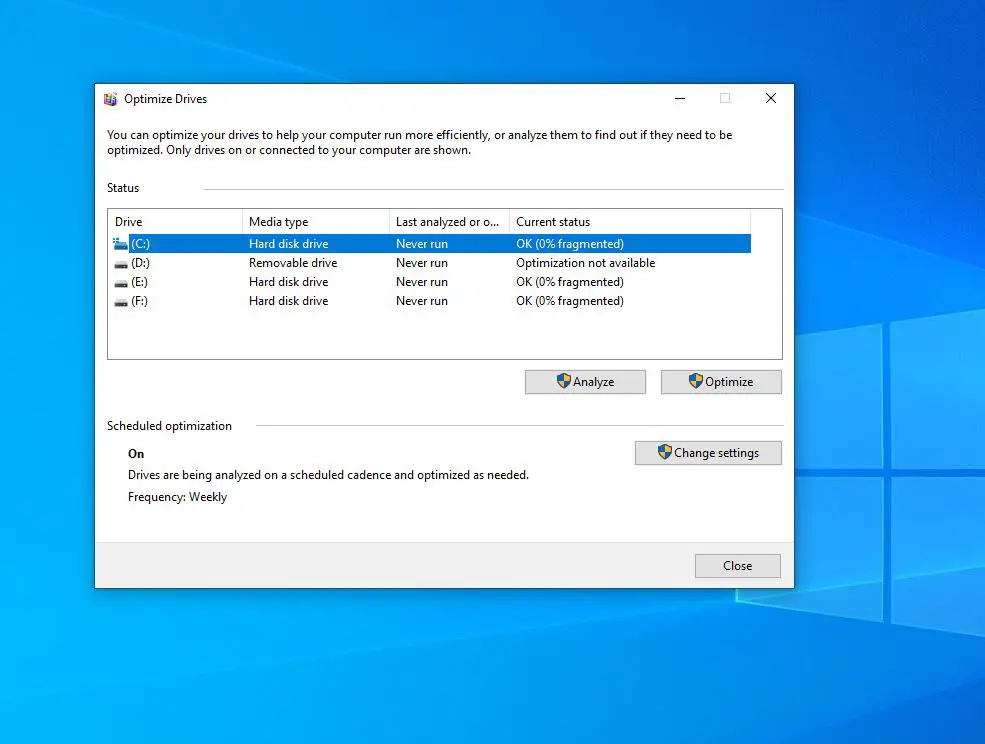Defragging your Hard Drive is one of the best ways to improve the performance of Windows 11/10. When you defragment the hard drive, all fragments of files are moved to contiguous clusters. This makes it easy for Windows to read the files and the computer starts working faster. Windows 10 has an internal tool that will automatically defragment disk drives to Optimize performance. But if you want to manually defrag or make changes to the optimization schedule, it can be done in a few easy steps. By default, Windows will save files in fragments across the disk. Each time you load a file, it will dynamically rebuild them.
Importance of Defragmenting Hard Drives
Over time, as you create, modify, and delete files on your hard drive, the data becomes fragmented. This means that parts of a file can be scattered across different physical locations on the drive. Fragmentation can lead to slower read and write speeds because the system has to navigate to multiple locations to retrieve a complete file. Defragmentation is the process of rearranging fragmented data, making your hard drive more efficient and improving overall system performance.
How to Defrag Disk Drive
Windows 10 comes equipped with a built-in defragmentation tool called “Optimize Drives.” This tool not only defragments your hard drive but also optimizes it for better performance.
Press Windows key + S, type defrag and select Defragment and optimize your drives
A window will appear with details about your hard disk drive (or drives if you have more than one), along with options to Analyze and Optimize these drives.
Now Select the system drive C and click on Analyze. This will Analyze the drive for fragmentation.
Note: Analyzing the drives will tell you how fragmented the drives are, and advise whether or not you need to optimize it.
If there are no fragmented files in the drive, Windows displays a message box stating that the disk does not need to be defragmented.
After Windows completes the analysis, click the Optimize button to start the defragmentation process on the selected volume.
Wait until Windows defragment disk drives successfully, restart the PC, and start using Windows 10 normally.
This can take anywhere between a few minutes to several hours depending on how fragmented your drive is.
If you want to change when scheduled optimizations are due to happen, click on “Change settings”. Here you can modify the frequency as well as which drives are defragged.
Note: While defragmentation is beneficial for traditional hard drives (HDDs), it is not recommended for solid-state drives (SSDs). SSDs use a different technology that doesn’t suffer from the same performance issues as HDDs due to fragmentation. I
How to defrag using a third-party tool
Defraggler is unique in that it allows you to defragment your entire drive. Or specific files or folders (fantastic if you want to defrag all of your large videos or all of your save game files.) The utility also supports “quick defrag,” which can speed up your drive and do get a lot of work done without the time required to do a full scan and defrag. The app is portable, and you can run it from a thumb drive if you need to work on multiple PCs. You can schedule the app to defrag your drive at regular intervals, and even tell Defraggler to only clean up free space on your drive. Here download the Tool and run As administrator.
Auslogics Disk Defrag (Free)
Disk Defrag from Auslogics goes a little further than simple disk defragmentation. The app will also optimize your file system for faster file reads and writes. And show you a list of fragmented files instead of a vague report of your hard drive’s fragmentation status. Also, this will even defragment single files and folders if you’re having a hard time with a specific file or application. Disk Defrag will also automatically defrag your system at specified times or when your PC is idle.
Fix Disk defragmenter does not run
If you find that you are unable to defragment or cannot run the defragment utility in Windows. Or that a drive or volume has been marked as having errors. Then open the command prompt as administrator and run the following command.
chkdsk c: /f /r
CHKDSK is short of Check Disk, C: is the drive letter you want to check, /F means fix disk errors and /R stands for recover information from bad sectors.
When it prompts “Would you like to schedule this volume to be checked the next time the system restarts? (Y/N)”. Answer Yes to that question by pressing the Y key on your keyboard and press Enter. Restart your computer. After restarting, the disk checking operation should start. Wait until Windows check your disk for errors.
Note: if your laptop or PC is using an SSD (solid-state disk) then there’s no need to defrag it.
Note Pad: It is strongly suggested that you don’t use the computer during the defragmentation process. For optimum results, it is better to leave the system alone until Windows finishes defragment disk Drives.
Also read


